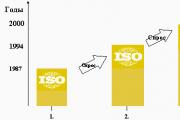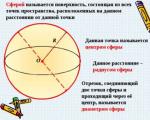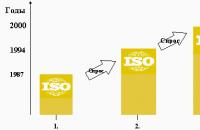Currently, the practice of opening retail stores by industrial organizations, which are their separate divisions and retail both the finished products of these organizations and purchased goods, has become quite widespread. V.V. talks about accounting and taxation of sales under a contract for retail trade of products of own production. Patrov and M.L. Pyatov, St. Petersburg State University.
Organizing the accounting of commodity transactions in your own stores raises a number of problems. These include: choosing a range of synthetic accounts to account for the movement of goods of own production in a store, establishing the accounting price of goods, qualifying for accounting and taxation purposes the facts of transfer of finished products to the store’s warehouse, calculating the amount of realized trade markup, etc.
The solution to these issues is hampered by the lack of direct regulatory requirements that determine the methodology for reflecting these transactions in accounting.
When reflecting transactions for the retail sale of finished products, first of all, the question arises of the qualification for accounting and taxation purposes of the facts of the transfer of finished products from the workshops and warehouses of the plant to the store. In this case, does the sale of goods take place, and, therefore, is the turnover of the transfer of valuables subject to VAT and other taxes on sales? Does a financial result arise already at this stage of the movement of goods, affecting the amount of taxable profit?
If a retail store is an independent legal entity in relation to the manufacturing plant (for example, a subsidiary of the plant), goods are sold under a purchase and sale agreement or transferred in pursuance of a commission agreement, mandate or agency agreement. In this case, the fact of transfer of goods must be reflected in the records of the parties to the transaction (the store and the manufacturing plant of the goods) in the manner established for recording the execution of the relevant contracts.
If the store is a structural subdivision of the manufacturing organization (and this is precisely the option we are considering), then the transfer of goods to the store’s warehouse in accordance with the current norms of civil and tax law cannot be qualified as a sale (sale) of them by the factory to the store, because such cannot have place between separate structural divisions of the same legal entity.
In this case, the norms of tax legislation directly refer us to the requirements of civil law. According to the general definition given by Article 39 of the Tax Code of the Russian Federation, the sale of goods for tax purposes is recognized as the fact of transfer of ownership of them to third parties on a reimbursable basis.
In accordance with the special definition of the concept of sales for VAT purposes, which is given in paragraph 1 of Art. 146 of the Tax Code of the Russian Federation, the sale of goods means the transfer of ownership of them to third parties, both on a paid and gratuitous basis. At the same time, according to paragraphs. 2 p. 1 art. 146 of the Tax Code of the Russian Federation, for VAT purposes, the transfer of goods for one’s own needs is recognized as a sale only if the costs of these goods are not deductible when calculating corporate income tax.
Consequently, according to the norms of the Tax Code of the Russian Federation, the transfer of goods to a retail outlet - a structural unit of an organization, as not implying the loss of the organization's ownership of these goods, is not their sale for tax purposes.
The turnover for the sale of these goods arises only after their retail sale to customers, i.e. the fact of transfer of ownership of goods to buyers.
According to the general requirements of the Instructions for using the chart of accounts, products transferred to the store should be reflected in a separate subaccount to account 43 “Finished products” (for example, “Finished products in the store”). The fact of transfer of products to the store, therefore, should be recorded in accounting by an entry in the debit of account 43 subaccount “Finished products in the store” and the credit of account 43 subaccount “Finished products in the warehouse”. However, this makes it impossible to account for it at sales prices, since account 42 “Trade margin”, according to the same Instructions for using the chart of accounts, is opened exclusively for account 41 “Goods”. Yes, and reflecting at sales prices finished products accounted for in one of the subaccounts to account 43 “Finished Products”, when their accounting in the remaining subaccounts for this account is carried out at cost, is incorrect, since one or another option for assessing what is reflected in any the accounting object's account should be applied to the account as a whole.
Moreover, quite often stores organized by production organizations sell both their own products and purchased goods, and the organization of accounting for the movement of goods only in total terms makes it difficult to write them off, provided that commodity transactions are reflected both in account 41 “Goods” and in account 43 “ Finished products." Therefore, in our opinion, a more rational option seems to be when the accounting of products transferred to the retail store of a manufacturing organization is carried out on account 41 “Goods”.
This makes it possible to record goods in the store at sales prices using account 42 “Trade margin” to reflect the trade markup, which greatly facilitates the accounting of transactions for the receipt and sale of goods. As for the fact that the Instructions for using the chart of accounts do not contain entries in the standard correspondence scheme:
Debit 41 "Goods" Credit 43 "Finished products"
then, according to this regulatory document, “in the event of facts of economic activity arising, correspondence for which is not provided for in the standard scheme, the organization can supplement it, observing the uniform approaches established by this instruction.”
Based on the provisions considered, the following methodology for accounting for transactions for the retail sale of finished products can be proposed:
The fact of transfer of finished products to a retail store is reflected by an entry in the debit of account 41 “Goods” subaccount “Products of own production” and the credit of account 43 “Finished products” for the cost of valuables received by the store.
Reflection of the amount of VAT related to the sales value of goods purchased by the store should be made on the credit of account 42 “Trade margin” subaccount “Trade margin on products of own production”. In this case, an entry in the debit of account 41 “Goods” subaccount “Products of own production” in correspondence with account 42 “Trade margin” subaccount “Trade margin for products of own production” is made for the amount of the store’s trade markup and VAT on the retail price of goods.
Example
1,000 units were delivered to the store. products, cost per unit. which is 200 rubles, and the retail price is 260 rubles. (excluding VAT - 20%). The following entries will be made in accounting:
Debit 41 "Goods" subaccount "Products of own production" Credit 43 "Finished products" - 200,000 rubles. (200 rub. x 1000);
Debit 41 "Goods" subaccount "Products of own production" Credit 42 "Trade margin" subaccount "Trade margin for products of own production" - 60,000 rubles. [(260 rub. - 200 rub.) x 1000];
Debit 41 "Goods" subaccount "Products of own production" Credit 42 "Trade margin" subaccount "Trade margin for products of own production" - 52,000 rubles. (260 rub. x 1000 x 20%].
Many enterprises sell their own products through structural divisions. How to reflect this in accounting? Does such a sale relate to retail trade and is it necessary to pay UTII? How to distribute expenses between two types of activities if, in addition to your own, purchased goods are also sold? The answers to these questions are in our article.
About Ladozhsky Understanding taxationLet's say a manufacturing enterprise sells finished products through its own store to end consumers. Of course, such sales fall under the concept of retail trade (Article 492 of the Civil Code of the Russian Federation). But does this activity need to be transferred to UTII? No, since the sale of products of own production (manufacturing) is not subject to Chapter 26.3 of the Tax Code of the Russian Federation. This is noted in section 346.27 of the main tax document.
Thus, this activity is taxed on a general basis or, if the established requirements are met, it can be transferred to a “simplified tax”.
We arrange the transfer to the department
The transfer of manufactured products from the warehouse to the structural unit where they will be sold is issued with an invoice for internal movement (form No. TORG-13). It is drawn up in two copies by the financially responsible person of the department handing over inventory items. The first serves as the basis for writing off products in the warehouse. The second is for the posting of valuables in the receiving department. The completed document is signed by the deliverer and the recipient and submitted to the accounting department to record the movement of inventory items.
Accounting
Accounting for the movement of finished products in departments engaged in trading activities is carried out in account 43 of the same name in a separate sub-account “Finished products in a non-trading organization”. This is provided for in paragraph 219 of the Methodological Guidelines for Accounting for Inventories (approved by Order of the Ministry of Finance of Russia dated December 28, 2001 No. 119n). The transfer of products from the main activity to the trading division is accounted for in account 43 as internal movement.
Sales are reflected in account 90 “Sales” in the generally established manner, as in operations for the sale of finished products from a warehouse.
Only in this case the subaccount “Finished products in a non-trading organization” of account 43 is credited.
Let's look at an example of how to reflect in accounting transactions involving the sale of own products by a trading division of an organization.
Example 1
The company Aurora LLC sells its own products in its store. The cost of finished products is 100,000 rubles, and the selling price is 177,000 rubles. The accountant of Aurora LLC will reflect operations on the movement of finished products as follows:
Debit 43 subaccount “Finished products in warehouse” Credit 20
– 100,000 rub. – products are received into the warehouse;
Debit 43 subaccount “Finished products in a non-trading organization” Credit 43 subaccount “Finished products in warehouse”
– 100,000 rub. – finished products were transferred from the warehouse to the sales division;
Debit 62 Credit 90
– 177,000 rub. – income from retail sales is reflected;
Debit 90 Credit 43 subaccount “Finished products in a non-trading organization”
– 100,000 rub. – the cost of finished products is written off;
Debit 90 Credit 68
– 27,000 rub. – VAT is charged;
Debit 90 Credit 99
– 50,000 rub. (177,000 – 100,000 – 27,000) – the financial result is written off at the end of the reporting month.
If purchased products are also soldIn this case, this type of activity falls under the concept of “retail trade”, provided for in Article 346.27 of the Tax Code of the Russian Federation. This means that a taxation system in the form of a single tax on imputed income can be applied. But only if such activities are transferred to UTII in the region where they are carried out. In addition, the area of the sales area should not exceed 150 square meters. m.
Please note: if, in addition to your own, purchased products are sold, a combination of two taxation regimes is inevitable. This means that it is necessary to ensure separate accounting of two types of activities (clause 7 of Article 346.26 of the Tax Code of the Russian Federation).
Let’s say an enterprise combines the general regime and imputation. For profit tax purposes, income and expenses related to UTII are not taken into account (clause 9 of Article 274 of the Tax Code of the Russian Federation). Accordingly, separate accounting of income and expenses is necessary. What if expenses cannot be shared? Then they are determined in proportion to the share of the organization’s income from “imputed” activities in the total income of the enterprise. Let's look at this situation using an example.
Example 2
The total income of the enterprise amounted to 1,000,000 rubles, including income from activities subject to UTII - 200,000 rubles. General business expenses that cannot be attributed to any one taxation regime - 300,000 rubles.
It is necessary to make a proportion:
(RUB 200,000 : RUB 1,000,000) x RUB 300,000 = 60,000 rub.
Thus, expenses for activities subject to UTII must include 60,000 rubles.
K1 coefficient in 2007When calculating UTII, the amount of basic profitability must be multiplied by the deflator coefficient K1. This is stated in paragraph 4 of Article 346.29 of the Tax Code of the Russian Federation.
In 2007, this coefficient was set at 1.096 (letter of the Ministry of Finance of Russia dated May 29, 2007 No. 03-11-02/151).
True, financiers previously insisted on using K1 in the amount of 1.241 (letter dated March 2, 2007 No. 03-11-02/62). Those who took advantage of these clarifications and applied this coefficient in the first quarter of 2007 now need to recalculate. To do this, you must submit an updated tax return for the first quarter of 2007. As a result, an overpaid amount will be revealed, which, upon application, can be used either to pay tax in the following tax periods, or returned to a bank account according to the rules established by Article 78 of the Tax Code of the Russian Federation.
Every person in his life at least once thought about creating his own production.
Is production profitable?
In the modern world, entrepreneurs try to follow the path of least resistance and prefer to invest their money in the development of various cafes, shops, etc.? High rents, lack of mutual understanding with landlords, competition, uncoordinated team work, and insufficient attendance often lead to the unprofitability of these establishments and their closure.
The optimal solution to the desire to have a permanent income is to create your own production. This is a rather complex process that requires the investment of a lot of effort, time and money. But with proper organization, a positive result will not be long in coming.
Cash investments
Many people think that production requires the investment of very large sums of money, because this is one of the areas with a high barrier to entry. But now in the modern world there are many opportunities to attract cash flows into your own business.
Firstly, there is such a thing as a loan. It is easy to issue and obtain from banks of the Russian Federation upon provision of the required package of documents. If your production is connected with agriculture or other activities related to import substitution, then there is a chance to get a loan on very favorable terms. To submit an application, it is necessary to prepare a number of documents: a detailed business plan, a feasibility study of the project, a certificate from the tax office confirming business activity.

You also have the opportunity to attract investments from crowdfunding platforms. To do this, you will need to review your project and convince people of its worthy future. There are quite a large number of such sites on the Internet.
It is also possible to start a business with minimal production that does not require large expenses. Do you have a garage, basement or unnecessary storage? So why not start using it in such a way that this area generates some income?
One of the richest countries in terms of production is China. For some reason, all people think that all factories in this country are giants. No, most Chinese manufacturers are small enterprises that generate good income. The majority of home-produced goods from the Middle Kingdom are supplied to Europe, America and to us, to Russia.

What will you have to face?
It must be said that production is a type of entrepreneurial activity in which frequent inspections, high taxes and pressure from the authorities cannot be avoided. It is worth noting that your production must be kept clean and tidy, because no one has canceled sanitary standards. A novice businessman should pay attention to the geolocation of the future enterprise. After all, in megacities it is very difficult to find a free niche and quickly start making high profits. In this regard, small towns have much better chances.
But on the other hand, there are a huge number of consumers in megacities, which plays into the hands of the manufacturer. You also need to understand that at first your production may bring in tiny money, and sometimes not pay off at all. The entrepreneur’s endurance and his ability to complete the job are very important here.

Choosing a Niche
What to produce? To answer this question, you need to understand in what area you would like to create your own production. It's the 21st century - a time of high technology. You always have access to the World Wide Web at your fingertips, where you can find many original ideas. You just need to strain a little and understand what products are not produced in the Russian Federation and why.
Even if the product you are interested in is still produced in Russia, you should not bypass it. After all, it often happens that the main components are produced abroad. And this is a reason to organize the production of these particular parts. The main thing is to approach this issue correctly and study it thoroughly. After all, to create your own production in our country there are all the necessary components: a developed domestic and foreign market, cheap labor. Only Chinese manufacturers have to spend a lot of money on logistics. So why does it work for them, but we shouldn’t?

Registration
Once you have decided what you will produce, you need to register the enterprise. Organizing your own production is possible within the framework of a legal entity, or a person can register as an “individual entrepreneur.” The second option is perfect for small production, while the first is relevant for medium and large enterprises. The difference between an individual entrepreneur and a legal entity is primarily determined by taxation and the cost of opening.
In order to explore which of these options is right for you, you need to make calculations that are based on several important factors:
- registration of a company;
- buying or renting a place;
- purchase or rental of tools;
- recruiting workers and paying wages at the first stage, when there is no constant revenue;
- advertising.

Sales of products
Selling products of one's own production is one of the final stages that brings an entrepreneur closer to making a profit. It is important to be able to correctly compose the selling price of a unit of goods, including direct manufacturing costs, overhead costs and a commodity margin, which includes a certain percentage of net profit.
To sell products of your own production, you need to open your own stores, or sell these goods through large retail outlets. Of course, the first option will bring you much more revenue, but in order to open your own stores, you will need to study this issue well and invest a large amount of money. At first, it is better to consider the second option, because you cannot yet assume whether your products will be sold at all. In this option, your main clients will be large wholesalers. This means that you will mainly sell only in large quantities, but it all depends on the area you choose and your desires. Over time, if you realize that things are going uphill, then, of course, you can think about opening your own points.
The final products of your own factory must have the necessary certificates; the products must comply with current GOSTs. It is also worth taking care of the timely registration of a license to sell goods.

Financial subtleties
In the process of organizing your own production, you need to be familiar with concepts such as “finished products” and “semi-finished products”.
If you work according to a standard store scheme, the question is how to capitalize the products purchased from private traders, if you work according to an agency scheme, as if we are just an intermediary in delivering products from the manufacturer to the client, the question is how not to attract the attention of the inspection authorities, since this already looks like to deliberately evade the law on consumer protection during distance selling.
Vadim
Hello, Vadim.
It seems to me that if you have the same product suppliers, then it’s really easiest for you to enter into an agency agreement with them to find buyers and take a commission from a % of sales. Plus, enter into a separate contract for the delivery/cargo transportation of goods.
Then it would be best for you to open an individual entrepreneur with two taxation systems. Cargo transportation will be under the simplified taxation system, and agency services at the simplified taxation system of 6%.
But, to avoid problems with regulatory authorities, I still recommend checking that farmers have all the necessary documents. The sale of food products is controlled more strictly than manufactured goods, and if someone, God forbid, gets poisoned, there will be a serious investigation.
Here are the documents for the sale of dairy products and vegetables
In addition, if you deliver food, your transport must comply with the Sanitary Rules for Food Trade Enterprises - SanPiN 2.3.5.021-94. Section “Sanitary Requirements for the Transportation of Food Products”.
A vehicle intended for the transportation of food cargo must have a sanitary passport of the appropriate type.
The driver (forwarder) is required to have a medical book with him, in which notes must be made that he has passed the appropriate medical commission.
The car body must be clean, which must be confirmed
relevant documents based on the verification carried out. That's why
special attention is paid to the procedure for washing the car body before
transportation of food products, as well as after it (requirements for
temperature of water and detergents, washing time, control after
disinfection, etc.).
Only specialized accredited organizations have the right to wash the body of a vehicle intended for the transportation of food products.
who, upon request, are obliged to provide the necessary
documents on the appropriate cleaning and disinfection procedures carried out.
The climatic conditions in the car body must satisfy
transportation requirements for each type of product. Thus,
perishable goods must be transported in a closed body on transport equipped with special refrigeration units,
capable of maintaining a certain climate regime. To them
include refrigerators and insulated trailers and semi-trailers.
Before submitting the vehicle for loading, the internal
temperature conditions must comply with the transportation standards of the category
transported cargo, as well as compliance with sanitary and hygienic standards
body cleanliness. Upon completion of loading, the vehicle must
be sealed if the transported cargo does not contain its own
sealed containers or packaging.
For transporting perishable goods over long distances
they may be heavily cooled or frozen beforehand if they
Of course, such a procedure is allowed (for example, meat, seafood, etc.).
Transportation of frozen products is carried out only in refrigerators,
capable of maintaining temperatures down to minus 20 degrees.
Questions about the need to use UTII by an organization located on the OSN when selling products of its own production, as well as about the procedure for documenting such transactions are considered by the experts of the service
Legal consulting GARANT
Ekaterina Lazukova and Svetlana Myagkova.
The LLC applies the general taxation regime; it is planned to sell goods of its own production to an individual by bank transfer. Will this transaction be considered retail and, accordingly, will it entail the payment of UTII? If not, what documents are used to formalize the transaction? Is it necessary to draw up a supply agreement, an invoice for payment, an invoice, or a delivery note?
First of all, it should immediately be pointed out that in the situation under consideration, the organization is not only not obliged to switch to UTII, but also does not have the right to do this, since the activity of selling goods of its own production is not subject to transfer to UTII. In turn, the procedure for documenting will depend on the type of agreement concluded with an individual.
Let us explain in more detail.
Application of the taxation system in the form of UTII
According to paragraph 1 of Art. 346.28 of the Tax Code of the Russian Federation, payers of UTII are organizations and individual entrepreneurs carrying out business activities subject to UTII on the territory of a constituent entity of the Russian Federation in which a single tax has been introduced.
In accordance with paragraph 1 of Art. 346.26 of the Tax Code of the Russian Federation, the taxation system in the form of UTII is established by the Tax Code of the Russian Federation, put into effect by regulatory legal acts of representative bodies of municipal districts, city districts, laws of federal cities of Moscow and St. Petersburg and is applied along with the general taxation regime and other taxation regimes provided for by the legislation of the Russian Federation about taxes and fees.
The taxation system in the form of UTII for certain types of activities can be applied to the types of business activities provided for in paragraph 2 of Art. 346.26 Tax Code of the Russian Federation. In particular, the taxation system in the form of UTII can be applied to the retail trade of goods.
The concept of retail trade is given in Art. 346.27 of the Tax Code of the Russian Federation, in accordance with this norm, retail trade is understood as business activity related to the sale of goods (including in cash, as well as using payment cards) on the basis of retail purchase and sale contracts. At the same time, this type of entrepreneurial activity does not include, in particular, the sale of products of one’s own production (manufacturing).
Thus, the activity of selling own-produced products, in the context of applying UTII, is not retail trade. It does not matter to whom and for what purposes the goods are sold. Accordingly, the organization cannot apply UTII in relation to such activities.
In addition, on January 1, 2013, a new version of clause 1 of Art. 346.28 of the Tax Code of the Russian Federation (Federal Law of June 25, 2012 N 94-FZ “On Amendments to Parts One and Two of the Tax Code of the Russian Federation and Certain Legislative Acts of the Russian Federation”).
From January 1, 2013, paragraph 1 of Art. 346.28 of the Tax Code of the Russian Federation provides that organizations and individual entrepreneurs switch to paying a single tax voluntarily.
Thus, since 2013, the mandatory procedure for switching to a taxation system in the form of UTII has been abolished. Taxpayers have the right to independently choose the tax regime for their business activities: the general taxation system, simplified tax system or UTII (letters of the Ministry of Finance of Russia dated November 6, 2012 N 03-11-06/3/75, dated August 13, 2012 N 03-11-06/3/59 , dated 06/01/2012 N 03-11-11/173).
That is, even if the activities carried out by the organization on the basis of the norms of Chapter. 26.3 of the Tax Code of the Russian Federation, falls under the types of activities the implementation of which may be subject to UTII, an organization in relation to such activities has the right to either apply UTII or keep records within the framework of the STS (STS, if there are appropriate rights to apply this taxation system).
In the situation under consideration, the organization applies DOS; therefore, in the case of carrying out activities that fall under UTII, the organization has the right to independently decide whether to apply UTII or DOS.
Please note that from the cumulative application of the provisions of Art. 346.27 of the Tax Code of the Russian Federation (definition of retail trade) and Art. 492 of the Civil Code of the Russian Federation, it follows that retail trade for the purposes of Chapter 26.3 of the Tax Code of the Russian Federation includes entrepreneurial activities related to the sale of goods both for cash and for non-cash payments under retail purchase and sale agreements, regardless of what category of buyers (individuals or legal entities ) these goods are sold (letters of the Ministry of Finance of Russia dated 04/05/2013 N 03-11-06/3/11238, dated 04/04/2013 N 03-11-11/137, dated 03/18/2013 N 03-11-11/107). That is, as part of activities falling under UTII, an organization can sell goods to both individuals and legal entities and receive payment for them in any form. Only the final purpose of using the sold product matters: for personal needs or for business activities (letters of the Ministry of Finance of Russia dated 08/08/2012 N 03-11-11/229, dated 05/21/2012 N 03-11-11/165, dated 05/05. 2012 N 03-11-11/144).
Documentation
The procedure for documenting the transaction in question will depend on the agreement under which the goods are sold to an individual: under a retail purchase and sale agreement or under a supply agreement.
In accordance with Art. 506 of the Civil Code of the Russian Federation, under a supply contract, the supplier-seller undertakes to transfer, within a specified period or time frame, the goods produced or purchased by him to the buyer for use in business activities or for other purposes not related to personal, family, home and other similar use.
According to Art. 492 of the Civil Code of the Russian Federation, under a retail purchase and sale agreement, a seller engaged in business activities of selling goods at retail undertakes to transfer to the buyer goods intended for personal, family, home or other use not related to business activities.
Thus, the main difference between the sale of goods under a retail purchase and sale agreement and a supply agreement is the ultimate purpose of using the goods purchased by the buyer: for personal use or for use in business activities. Please note that current legislation does not oblige the seller to control the intended use of the goods purchased from him.
The organization must make its own decision about what kind of agreement will be concluded in this case.
In this case, it is necessary to take into account the provisions of Art. 493 of the Civil Code of the Russian Federation, according to which, unless otherwise provided by law or contract, a retail purchase and sale agreement is considered concluded from the moment the seller issues a cash receipt or sales receipt or other similar document confirming payment for the goods to the buyer.
Thus, when carrying out activities under a retail purchase and sale agreement, the issuance of any documents to the buyer other than a cash register receipt (another similar document) is not provided. However, there is no prohibition on issuing other documents to the buyer (invoice, delivery note, etc.).
To control the timely and complete reflection of data on the movement of goods during retail trade, any independently developed form of consignment note (or other similar document) can be used, provided that such form meets the requirements for primary documents (Part 2 of Article 9 Federal Law of December 6, 2011 N 402-FZ “On Accounting” (hereinafter referred to as Law N 402-FZ)).
As for the wholesale supply agreement, the sale of goods under such an agreement is drawn up with a consignment note drawn up in the TORG-12 form, or in another independently developed form indicating the mandatory details (Part 2 of Article 9 of Law No. 402-FZ). When concluding a wholesale supply agreement, a second copy of the invoice (another document confirming shipment) is transferred to the buyer.
Regarding the preparation of the invoice, we note the following. In accordance with paragraph 1 of Art. 169 of the Tax Code of the Russian Federation, an invoice is a document that serves as the basis for the buyer to accept for deduction the amounts of value added tax (VAT) presented by the seller of goods (works, services), property rights.
An individual, in accordance with paragraph 1 of Art. 143 of the Tax Code of the Russian Federation, is not a VAT payer, that is, he does not need an invoice issued by the seller.
At the same time, according to the norm of the Tax Code of the Russian Federation (clause 3 of Article 169 of the Tax Code of the Russian Federation), taxpayers are required to draw up invoices, as well as keep logs of received and issued invoices, purchase books and sales books when performing transactions for the sale of goods (works). , services) recognized as subject to VAT.
According to the provisions of paragraph 3 of Art. 168 of the Tax Code of the Russian Federation, when selling goods (work, services), as well as upon receiving amounts of payment, partial payment on account of upcoming deliveries of goods (performance of work, provision of services), appropriate invoices are issued no later than five calendar days counting from the day of shipment of goods (performance works, provision of services) or from the date of receipt of payment amounts, partial payment on account of upcoming deliveries of goods (performance of work, provision of services), transfer of property rights.
Moreover, in accordance with paragraph 7 of Art. 168 of the Tax Code of the Russian Federation are not required to issue invoices when selling goods for cash to organizations and individual entrepreneurs in retail trade and public catering, as well as those performing work and providing paid services directly to the population. In this case, the requirements for preparing payment documents and issuing invoices are considered fulfilled if the seller issues the buyer a cash receipt or other document of the established form.
From the above it follows that when carrying out retail trade, invoices may not be issued only for cash payments.
Thus, in the case under consideration, the organization, when receiving payment from an individual by bank transfer, must issue an invoice and register it in the sales book. In this case, the organization has the right not to include an invoice in the package of documents presented to an individual when selling goods. At the same time, the legislation does not contain a ban on issuing an invoice to an individual when he purchases goods by bank transfer.
The texts of the documents mentioned in the experts’ response can be found in the legal reference system






















